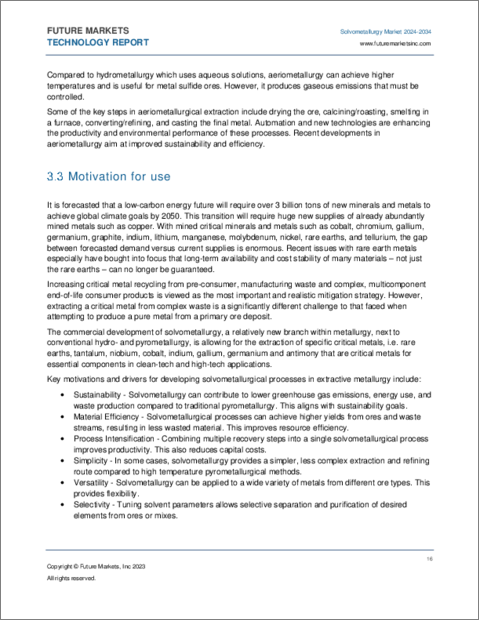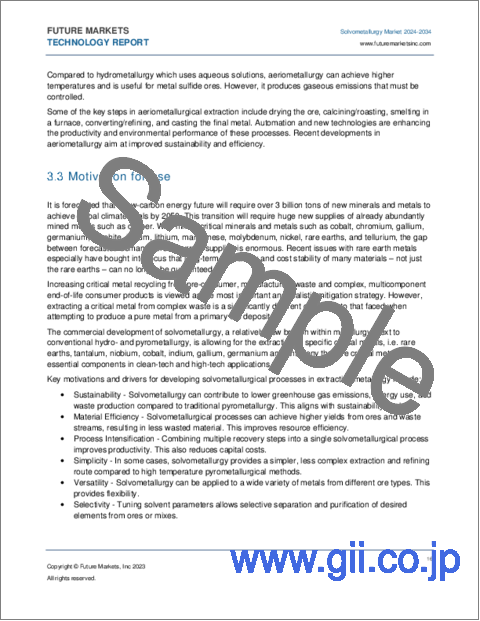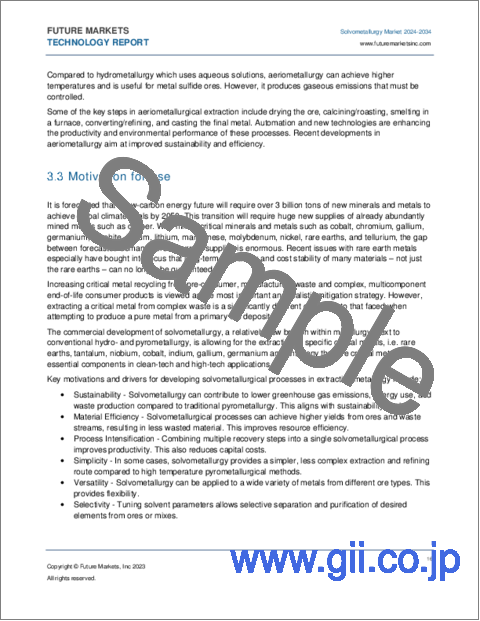|
|
市場調査レポート
商品コード
1329011
ソルボメタラジーの世界市場(2024年~2034年)The Global Market for Solvometallurgy 2024-2034 |
||||||
|
|||||||
| ソルボメタラジーの世界市場(2024年~2034年) |
|
出版日: 2023年08月14日
発行: Future Markets, Inc.
ページ情報: 英文 114 Pages, 27 Tables, 12 Figures
納期: 即納可能
|
- 全表示
- 概要
- 図表
- 目次
コバルト、クロム、ガリウム、ゲルマニウム、グラファイト、インジウム、リチウム、マンガン、モリブデン、ニッケル、レアアース、テルルなど、採掘される重要な鉱物や金属に対するエネルギーやハイテク市場からの世界の需要は増加の一途をたどっており、供給を増やし、中国からの輸入への依存を減らすことはいずれも極めて重要です。2050年までに世界の気候変動目標を達成するため、30億トンを超える新しい鉱物や金属が必要になる可能性がある低炭素エネルギーの未来にとって、これらの材料の長期的な利用可能性とコストの安定性は極めて重要です。
ソルボメタラジーは、従来のプロセスと比較して、温室効果ガス排出、エネルギー使用、廃棄物生産を削減し、金属回収率を向上させ、鉱石や廃棄物の流れからのより高い収率を低いコストで達成することに寄与できます。市場の発展は、将来の需要を満たすための金属と鉱物の抽出および回収にとって重大です。
当レポートでは、世界のソルボメタラジー市場について調査分析し、技術の分析、市場の促進要因と課題、市場規模の推計、企業プロファイルなどを提供しています。
目次
第1章 調査手法
第2章 用語と定義
第3章 技術分析
- 概要
- その他のプロセス
- 使用の動機
- 主な技術、材料、プロセス
- 比較分析
- 溶媒抽出
- バイオリーチング
- 塩化物/塩素の浸出
- 超臨界流体抽出
- イオン液体
- 直接溶媒抽出
- ヒープリーチング
- 加圧酸化浸出
- マイクロ波加熱
- 超音波アシスト浸出
- レジンインパルプ
- 電解採取
- その他
- 加工・抽出される金属と鉱物
- 銅
- ニッケル
- コバルト
- 希土類元素(REE)
- リチウム
- 金
- ウラン
- 亜鉛
- マンガン
- タンタル
- ニオブ
- インジウム
- ガリウム
- ゲルマニウム
- アンチモン
- スカンジウム
第4章 市場の分析
- 市場の現状
- 市場参入企業
- SWOT分析
- 市場マップ
- バリューチェーン
- 過去と現在の市場規模の推計
- 総収益(2019年~2022年)
- プロセス別、技術別
- 地域別
- 成長の推計と予測
- 推定収益(2023年~2034年)
- プロセス別、技術別
- 地域別
- 市場の促進要因と成長要因
- 市場の課題
第5章 企業プロファイル(38社のプロファイル)
第6章 参考材料
List of Tables
- Table 1. Comparison of technologies and processes
- Table 2. Markets and applications: copper
- Table 3. Markets and applications: nickel
- Table 4. Markets and applications: cobalt
- Table 5. Markets and applications: rare earth elements
- Table 6. Markets and applications: lithium
- Table 7. Markets and applications: gold
- Table 8. Markets and applications: uranium
- Table 9. Markets and applications: zinc
- Table 10. Markets and applications: manganese
- Table 11. Markets and applications: tantalum
- Table 12. Markets and applications: niobium
- Table 13. Markets and applications: indium
- Table 14. Markets and applications: gallium
- Table 15. Markets and applications: germanium
- Table 16. Markets and applications: antimony
- Table 17. Markets and applications: scandium
- Table 18. Market players in solvometallurgy
- Table 19. Market players in hydrometallurgical processes and technologies
- Table 20. Global solvometallurgy market revenues, 2019-2022 (millions USD)
- Table 21. Global solvometallurgy market revenues, 2019-2022, by process and technology (millions USD)
- Table 22. Global solvometallurgy market revenues, 2019-2022, by region (millions USD)
- Table 23. Global solvometallurgy market revenues, 2023-2034 (millions USD)
- Table 24. Global solvometallurgy market revenues, 2023-2034, by process and technology (millions USD)
- Table 25. Global solvometallurgy market revenues, 2023-2034, by region (millions USD)
- Table 26. Market drivers and growth factors
- Table 27. Market challenges in solvometallurgy
List of Figures
- Figure 1. Different types of metal extraction
- Figure 2. Solvent extraction (SX) in hydrometallurgy
- Figure 3. Heap leaching schematic
- Figure 4. SWOT analysis: solvometallurgy market
- Figure 5. Market map: solvometallurgy market
- Figure 6. Solvometallurgy market value chain
- Figure 7. Global solvometallurgy market revenues, 2019-2022 (millions USD)
- Figure 8. Global solvometallurgy market revenues, 2019-2022, by technology (millions USD)
- Figure 9. Global solvometallurgy market revenues, 2019-2022, by region (millions USD)
- Figure 10. Global solvometallurgy market revenues, 2023-2034 (millions USD)
- Figure 11. Global solvometallurgy market revenues, 2023-2034, by technology (millions USD)
- Figure 12. Global solvometallurgy market revenues, 2023-2034, by region (millions USD)
Solvometallurgy involves the use of solvents other than water for mineral processing and metal extraction. It can provide environmental and economic benefits compared to traditional processes like pyrometallurgy. With ever increasing global demand from energy and high-tech markets for mined critical minerals and metals such as cobalt, chromium, gallium, germanium, graphite, indium, lithium, manganese, molybdenum, nickel, rare earths, and tellurium, the need to both increase supply and reduce dependence on imports from China is of critical importance. Long-term availability and cost stability of these materials is critical for a low-carbon energy future that will potentially require over 3 billion tons of new minerals and metals to achieve global climate goals by 2050.
Solvometallurgy can contribute to lower greenhouse gas emissions, energy use, and waste production compared to traditional processes, improve metal recoveries and achieve higher yields from ores and waste streams, at a lower cost. The development of the global market for solvometallurgy will be crucial for the extraction and recovery of metals and minerals to meet future demand. Players in the market include start-ups, mining companies and chemical producers.
Report contents include:
- Technology analysis
- Description of other processes.
- Market drivers and challenges.
- Key technologies and processes including:
- Solvent Extraction.
- Bioleaching.
- Chloride/Chlorine Leaching.
- Supercritical Fluid Extraction.
- Ionic Liquids.
- Heap Leaching.
- Direct Solvent Extraction.
- Pressure Oxidation Leaching.
- Microwave Heating.
- Ultrasound-Assisted Leaching.
- Resin-in-Pulp.
- Electrowinning.
- Advanced materials
- Metal-Organic Frameworks (MOFs).
- Deep eutectic solvents.
- Nanoparticles.
- Carbon nanotubes.
- Conductive polymers.
- Bio-materials.
- Analysis of Metals and minerals processed and extracted including:
- Copper.
- Nickel.
- Cobalt.
- Rare Earth Elements (REE).
- Lithium.
- Gold.
- Uranium.
- Zinc.
- Manganese.
- Tantalum.
- Niobium.
- Indium.
- Gallium.
- Germanium.
- Antimony.
- Scandium.
- Commercial solvometallurgy market analysis:
- Current state of the market and future outlook.
- Market players.
- SWOT analysis.
- Market map & value chain.
- Historical and current market size estimates.
- Profiles of 38 companies. Companies profiled include BacTech, BASF, Berkeley Energia, EnviroMetal Technologies, Metso, PH7, Rio Tinto and Sumitomo Metal Mining.
TABLE OF CONTENTS
1. RESEARCH METHODOLOGY
2. TERMS AND DEFINITIONS
3. TECHNICAL ANALYSIS
- 3.1. Description
- 3.2. Other processes
- 3.2.1. Pyrometallurgy
- 3.2.2. Hydrometallurgy
- 3.2.3. Electrometallurgy
- 3.2.4. Aeriometallurgy
- 3.3. Motivation for use
- 3.4. Key technologies, materials and processes
- 3.4.1. Comparative analysis
- 3.4.2. Solvent extraction
- 3.4.2.1. Process description
- 3.4.2.2. Advantages
- 3.4.2.3. Challenges
- 3.4.3. Bioleaching
- 3.4.3.1. Process description
- 3.4.3.2. Advantages
- 3.4.3.3. Challenges
- 3.4.4. Chloride/Chlorine Leaching
- 3.4.4.1. Process description
- 3.4.4.2. Advantages
- 3.4.4.3. Challenges
- 3.4.5. Supercritical Fluid Extraction
- 3.4.5.1. Process description
- 3.4.5.2. Advantages
- 3.4.5.3. Challenges
- 3.4.6. Ionic Liquids
- 3.4.6.1. Process description
- 3.4.6.2. Advantages
- 3.4.6.3. Challenges
- 3.4.7. Direct Solvent Extraction
- 3.4.7.1. Process description
- 3.4.7.2. Advantages
- 3.4.7.3. Challenges
- 3.4.8. Heap Leaching
- 3.4.8.1. Process description
- 3.4.8.2. Advantages
- 3.4.8.3. Challenges
- 3.4.9. Pressure Oxidation Leaching
- 3.4.9.1. Process description
- 3.4.9.2. Advantages
- 3.4.9.3. Challenges
- 3.4.10. Microwave Heating
- 3.4.10.1. Process description
- 3.4.10.2. Advantages
- 3.4.10.3. Challenges
- 3.4.11. Ultrasound-Assisted Leaching
- 3.4.11.1. Process description
- 3.4.11.2. Advantages
- 3.4.11.3. Challenges
- 3.4.12. Resin-in-Pulp
- 3.4.12.1. Process description
- 3.4.12.2. Advantages
- 3.4.12.3. Challenges
- 3.4.13. Electrowinning
- 3.4.13.1. Process description
- 3.4.13.2. Advantages
- 3.4.13.3. Challenges
- 3.4.14. Other
- 3.4.14.1. Metal-Organic Frameworks (MOFs)
- 3.4.14.2. Deep eutectic solvents
- 3.4.14.3. Nanoparticles
- 3.4.14.4. Carbon nanotubes
- 3.4.14.5. Conductive polymers
- 3.4.14.6. Bio-materials
- 3.5. Metals and minerals processed and extracted
- 3.5.1. Copper
- 3.5.1.1. Global copper demand and trends
- 3.5.1.2. Markets and applications
- 3.5.1.3. Copper extraction and recovery
- 3.5.2. Nickel
- 3.5.2.1. Global nickel demand and trends
- 3.5.2.2. Markets and applications
- 3.5.2.3. Nickel extraction and recovery
- 3.5.3. Cobalt
- 3.5.3.1. Global cobalt demand and trends
- 3.5.3.2. Markets and applications
- 3.5.3.3. Cobalt extraction and recovery
- 3.5.4. Rare Earth Elements (REE)
- 3.5.4.1. Global Rare Earth Elements demand and trends
- 3.5.4.2. Markets and applications
- 3.5.4.3. Rare Earth Elemens extraction and recovery
- 3.5.4.4. Recovery of REEs from secondary resources
- 3.5.5. Lithium
- 3.5.5.1. Global lithium demand and trends
- 3.5.5.2. Markets and applications
- 3.5.5.3. Lithium extraction and recovery
- 3.5.6. Gold
- 3.5.6.1. Global gold demand and trends
- 3.5.6.2. Markets and applications
- 3.5.6.3. Gold extraction and recovery
- 3.5.7. Uranium
- 3.5.7.1. Global uranium demand and trends
- 3.5.7.2. Markets and applications
- 3.5.7.3. Uranium extraction and recovery
- 3.5.8. Zinc
- 3.5.8.1. Global Zinc demand and trends
- 3.5.8.2. Markets and applications
- 3.5.8.3. Zinc extraction and recovery
- 3.5.9. Manganese
- 3.5.9.1. Global manganese demand and trends
- 3.5.9.2. Markets and applications
- 3.5.9.3. Manganese extraction and recovery
- 3.5.10. Tantalum
- 3.5.10.1. Global tantalum demand and trends
- 3.5.10.2. Markets and applications
- 3.5.10.3. Tantalum extraction and recovery
- 3.5.11. Niobium
- 3.5.11.1. Global niobium demand and trends
- 3.5.11.2. Markets and applications
- 3.5.11.3. Niobium extraction and recovery
- 3.5.12. Indium
- 3.5.12.1. Global indium demand and trends
- 3.5.12.2. Markets and applications
- 3.5.12.3. Indium extraction and recovery
- 3.5.13. Gallium
- 3.5.13.1. Global gallium demand and trends
- 3.5.13.2. Markets and applications
- 3.5.13.3. Gallium extraction and recovery
- 3.5.14. Germanium
- 3.5.14.1. Global germanium demand and trends
- 3.5.14.2. Markets and applications
- 3.5.14.3. Germanium extraction and recovery
- 3.5.15. Antimony
- 3.5.15.1. Global antimony demand and trends
- 3.5.15.2. Markets and applications
- 3.5.15.3. Antimony extraction and recovery
- 3.5.16. Scandium
- 3.5.16.1. Global scandium demand and trends
- 3.5.16.2. Markets and applications
- 3.5.16.3. Scandium extraction and recovery
- 3.5.1. Copper
4. MARKET ANALYSIS
- 4.1. Current state of the market
- 4.2. Market players
- 4.3. SWOT analysis
- 4.4. Market map
- 4.5. Value chain
- 4.6. Historical and current market size estimates
- 4.6.1. Total revenues 2019-2022
- 4.6.2. By process and technology
- 4.6.3. By region
- 4.7. Growth projections and forecasts
- 4.7.1. Estimated revenues 2023-2034
- 4.7.2. By process and technology
- 4.7.3. By region
- 4.8. Market drivers and growth factors
- 4.9. Market challenges






